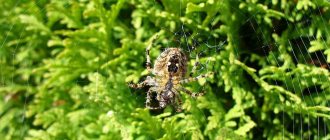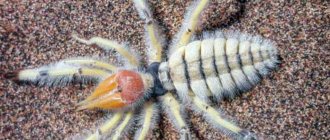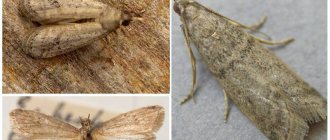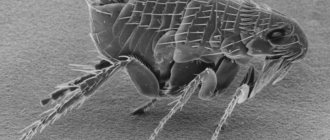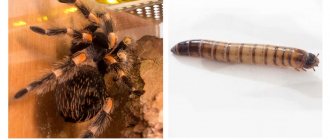There are more than 40 thousand species of spiders in the world, which differ in size and color, but in appearance they are all almost the same. Among such a variety of species, there are both very small spiders and large ones, reaching 10 cm in size, or even more. If many species eat small insects, then there are species that feed on small rodents, birds, etc. Some species pose a mortal danger to human health due to their strong poison. For those who are planning to visit hot countries, it is advisable to know what the largest spiders in the world look like.
Nephila the goldweaver
This is a representative of those spiders that inhabited our planet back in the Jurassic period. Nephiles represent a class of orb-weaving spiders and are distinguished by their rather large size (up to 4 cm), and also by the fact that they weave a huge web. Together with their limbs, their size reaches a maximum of 15 cm, with females being much larger than males. The main habitats are trees, which is why this species is also called tree spiders. In nature, they prefer countries located in the hottest regions of our planet.
Since they live in trees, they place their web between tree branches, where various insects come across. The female is located in the center of the hunting web, and males during the mating season are located closer to its edge. The main color of this species is greenish-yellow, with the addition of red. Although the venom of the nephilus goldworm is highly toxic, it is not fatal to humans.
Ornamental Rajai Tarantula
The body length of the tarantula is 7–8 cm, and the leg span is 15–20 cm. This is a relatively young species: scientists first encountered it in 2009.
Ornamental tarantulas are popular among breeders due to their unusual bright colors
Ornamental tarantulas can be found in Sri Lanka. They prefer to place their nests in old trees, but due to deforestation, spiders are forced to move into ruins and abandoned houses. Ornamental tarantulas are very rare. Scientists fear that due to the destruction of their natural habitat, spiders may disappear from the face of the earth.
Tegenaria brownie
This type of spider is widespread throughout Europe and is also called the large house spider. It also inhabits the countries of Central Asia, Africa, as well as Uruguay and Argentina. The length of its body is about 7 and a half centimeters, and together with the limbs - about 15 cm maximum. The body is pale gray in color, and the front legs are brown. Females of this species constantly carry a cocoon with eggs with them until the spiders are born. Tegenaria moves quite quickly. Prefers to live in caves, as well as in abandoned outbuildings. Since this species also chose hot countries for its life activities, it is very difficult to meet it.
10 BIGGEST SPIDERS IN THE WORLD.
Tegenaria wall
The length of the body of the tegenaria is only 3 cm, but the span of the legs reaches 13–14 cm. Due to the curvature of the limbs, the spider seems gigantic, although it is the smallest representative of the rating.
Tegenaria is a very aggressive spider: during conflicts over prey, arthropods often kill relatives
Tegenaria lives mainly in Africa, but occasionally spiders of this species are found in Asia. They prefer to build nests in old and abandoned houses, and often live next to people. Fortunately, tegenaria is not dangerous for humans. Cannibalism is common among this species. Tegenaria are also one of the fastest spiders, but do not cope well over long distances.
Brazilian wandering spider
These representatives of arachnids are also called banana spiders. To date, 8 varieties of banana spiders are known, the body size of which reaches 5 cm, and together with the legs, all 15 and no less. For their life activities, they choose areas with high humidity, which are typical for Central and South America, as well as the forests of Venezuela and the northern regions of Brazil. The spider is called a wandering spider because it constantly migrates in search of food. Scientists also divide them into types: the running type, which overtakes its potential victim through fast movements, and the jumping type, which provides itself with food through fast jumps. The wandering spider's diet is very varied, as it preys on other species of spiders, lizards, birds, etc. This is not only one of the largest representatives of the arachnid order, but also a species that has a fairly strong poison. The spider's body is brown in color, and a lot of sensitive bristles can be seen on the body. During the daytime, these predators stay in their shelters, and at night they go out hunting.
Important point! The Brazilian wandering spider is listed in the Guinness Book of Records as the most poisonous species.
The largest spiders in the world
Huge spiders lived on the planet even during the time of dinosaurs; in those days, their size was not perceived as something unusual or unnatural. Acquaintance with such giant spiders living today can evoke different feelings: for some - a state of panic, for others - admiration. There is a top 10 list of these representatives of the animal world according to their parameters.
Nephila
In honorable tenth place on the list of the largest spiders in the world is the large Nephila. Translated from Greek as “who loves to weave.” Most often, nephiles are found in the hot climatic conditions of America, Australia, Asia, and Africa. These representatives of arthropods are characterized by the presence of a body up to 4 centimeters and legs over 12 centimeters long. But these sizes are more typical for females.
The males of these arachnids are much smaller - up to 10 centimeters including legs. Green and yellow color with some transition to a reddish tint and white belly and head is a characteristic color scheme. This arachnid weaves not only the largest, but also a very strong and durable web.
Find out why people are afraid of spiders and what this phobia is called.
Fishermen in Southeast Asia, as well as Oceania, use the webs made by these spiders as fishing nets. The web is woven between the branches, and flies, butterflies, birds and other living creatures get caught in it.
The female sits in the center; during the mating season, the males sit at the edges of the web, waiting. Nephil's bite is quite painful; the skin at the site of injury immediately turns red, and in some cases becomes covered with blisters.
Important! The venom of this arachnid is toxic, but it is not fatal to humans.
Tegenaria wall
The name itself indicates that this type of arachnid prefers to stay on the walls of caves and non-residential buildings, which is why it is also considered a giant house spider. The size of its body is up to 8 centimeters, but due to the large span of its legs, sometimes reaching 13 centimeters, and their amazing curvature, this representative of arthropods looks even larger.
Tegenaria wall is characterized by a pale gray color and a brown tint to the legs. These spiders are excellent runners over impressive distances. In the fight for their favorite prey, they are capable of killing their own brothers. Tegenaria wall is quite rare, as it lives in Asian and African territories, in Uruguay and Argentina. This species ranks ninth in size.
Brazilian wandering spider
The eighth place in the parade of the largest spiders on the planet allows this arthropod to be occupied by its rather impressive dimensions: with a relatively not very voluminous body ranging from 5 to 7 centimeters, it has legs more than 17 centimeters long. Seeing such a spider, with a total size of almost a quarter of a meter, everyone will be wary at best.
Did you know? The Brazilian wandering spider is listed in the Guinness Book of Records as the most dangerous and poisonous species of arachnid.
Its body is characterized by a brownish color and the presence of hairs with increased sensitivity. There are 8 subspecies of this arachnid. There are also those that run, which overtake their prey at great speed, and those that jump, which strike their prey while jumping. This species of arachnid received its full name for its constant desire to move in search of new prey and food.
These spiders eat a variety of foods:
- Zhukov;
- reptiles;
- birds;
- other arachnids.
They hunt at night, hiding under stones, in crevices, and in houses during the day.
But these representatives of arachnids love to eat tropical fruits, especially bananas. That's why they are often found in boxes of these exotic fruits. Important! The Brazilian wandering spider will not attack a person first, so if you see it, it is better not to touch it. This feature of this animal has helped save more than one human life.
Cerbral Arabian
Cerbal Arabian, ranked seventh in the ranking, lives in the Israeli, Arabian and Jordanian deserts. Therefore, its appearance helps it feel as comfortable as possible among the sands: an inconspicuous yellow color, black lines on its paws, and its body covered with hairs.
Its relatively small body of 3 centimeters has legs, the length of which is on average 14 centimeters, but can reach up to 20. Females, as is often the case with arachnids, are larger than males.
Did you know? The Arabian cerbalus lives only at night, hiding from the burning sunlight during the day, so scientists became aware of this species only in 2003.
Baboon spider
This representative of the arachnids, which belongs to the tarantula family and took sixth place in the list of the largest, was named so for the similar appearance of its limbs to the fingers of a monkey. The paws of this animal can grow up to 30 centimeters, while the size of the body is not at all impressive - from 5 to 6 centimeters, but can reach 10.5 cm. It has hair, the color of the body varies in brown and gray tones, and has slightly noticeable black dots and stripes that can create a certain pattern.
Because of their habitat, these representatives of arthropods are often called the African tarantula, as well as the Red Cameroon baboon spider.
Read about which spiders can be kept at home and what conditions need to be created for them.
Like other arachnids, baboon spiders are cannibals by nature.
These arachnids carry out the process of hunting for prey at night and eat:
- Zhukov;
- reptiles;
- amphibians;
- scorpions;
- cockroaches;
- butterflies;
- termites.
These spiders pose virtually no threat to humans if left undisturbed.
If protection is necessary, the venom released by a baboon spider when it bites a person can lead to many hours of paralysis, causing vomiting and shock. Did you know? Of interest is the way the Baboon Spider attacks, attacks or defends itself: standing on its hind legs, it begins to hiss like a snake.
Colombian purple tarantula spider
Fifth place in size was taken by the rather rare Colombian purple tarantula spider, which was based in the humid tropics of South American territories. The originality of the velvety black color of the body, the star-shaped pattern on it and the purple with a crimson tint of the legs, as well as the amazing hairiness of these arachnid representatives, makes it tempting to keep them at home as pets.
When keeping the Colombian purple tarantula as a pet, it is necessary to take into account their ability to be aggressive, as well as the possibility of allergic manifestations when a person comes into contact with its hairs. But they do not pose a particular danger to people.
The size of the body of this representative of arachnids can reach 10 centimeters, and its limbs can grow up to 25 centimeters. As a rule, it hunts from shelters, and its diet includes:
- rodents;
- frogs;
- various insects;
- birds.
Thanks to his passion for birds, he got his name. Females live up to 15 years, while males live only a couple of years. The number of these representatives of arachnids on the globe is very low, so it is not so easy to meet them.
Phalanx
The Phalanx, ranked fourth in the list of the largest known spiders, lives in a halo from the Pyrenees to the Gobi Desert. Salpuga is another and more correct name for this species; translated it means “running away from the sun.” Also found are the names bihork, phalanx spider, wind scorpion and some others. But this species received its main name due to the presence of some bulges on the head, similar to camel humps.
The body size of these spiders is up to 8 centimeters, the limb span is up to 28 cm. The color of the body of these animals ranges from yellow to brown. There are elongated hairs on the paws. Phalanxes can reach speeds of up to 16 km/h. They are active at night and their prey includes:
- beetles;
- rodents;
- reptiles;
- feathered.
One thousand is the variety of these arachnids.
Important! Phalanxes are capable of attacking a person. They do not have poison, but they may well bite through the skin, cause very painful sensations, as well as blood poisoning due to the presence of putrefactive residues on the chelicerae. The bite site is treated with an antiseptic as soon as possible, and if an inflammatory process occurs, an antibiotic is taken.
Salmon pink tarantula spider
An honorable third place was taken by the Salmon-pink tarantula spider, which is found in Brazil. It is often the subject of breeding at home. Their shaggy body up to 10 centimeters with sweeping thirty-centimeter paws, the originality of black in the center with a gradual transition to gray color on the limbs with pink splashes - all this makes the contemplation of this representative of arachnids unforgettable.
The salmon-pink tarantula spider is able to protect itself with the help of hair, which is characterized by stinging and can cause allergic reactions. They shake off the poison from it when necessary for protection, while raising their forelimbs.
Did you know? The pink tarantula was first
in Brazil in 1917.
The females of these representatives of the arthropod family are always larger than the males, and they live much longer, their age can reach 15 years. By their nature, these animals are aggressive. Birds, snakes, and lizards serve as food for them. These arachnids are real killers, with the lightning-fast ability to attack and defeat their prey in a matter of seconds.
Giant crab spider
In second place is a truly huge representative of arachnids - the Giant Crab Spider. The span of its limbs significantly exceeds 30 centimeters, while the body is not very different in size from other species. It was the curvature of the paws that allowed it to get its name for its resemblance to a crab. Thanks to this shape of the limbs, this animal easily climbs tall trees and penetrates into crevices inaccessible to others.
The unusual ability of this spider is its ability, using the shape of its limbs, to move not only forward, but also to the sides. And he does it quite quickly. Thanks to this ability, it belongs to the sidewalker family.
The color of these giants varies from grayish, light brown to black and white; the body has sparse hair. The females of these representatives of arachnids are always ready to the last to defend their brood. These animals live in the lands of Australia. Their favorite places to live are the bark of large trees and rocks, where they hide under them. These representatives of the arthropod family move quickly by jumping and also instantly overtake their prey and kill it by injecting a toxic substance.
They prefer to eat:
- various insects;
- frogs;
- invertebrates.
The poison does not pose a deadly threat to the human body, but it is better to avoid bites from this predator. After a bite, headaches, vomiting, nausea, and swelling reactions may occur.
Goliath tarantula
The most honorable first place in terms of its dimensions is occupied by the Goliath Birdeater. This is the biggest spider in the world. The impressive parameters of this representative of arachnids evoke eerie and scary sensations even among those who consider themselves brave. The shaggy, voluminous body, the weight of which is more than 200 grams, the limbs, the size of which reaches 40 centimeters, and the presence of two and a half centimeter poisonous fangs in the mouth make the presented spectacle impressive. The body of females grows up to 10 cm, males - 8.5 cm. Its color is all shades of brown, on the limbs there are transverse white stripes and reddish hairs.
This giant lives in the tropics of South America, most often in Brazil, Venezuela and Suriname. Here, its habitats become half-meter-long burrows, covered with cobwebs and located in areas with high humidity and swampiness. The goliath tarantula with large eyes has excellent night vision and quick reactions.
Pursuing its prey, it attacks it from ambush with great speed, plunging its fangs deep into the body. It is distinguished by its aggressiveness, before attacking, it makes frightening sounds and shakes off the allergenic substance from the hair.
Their victims are:
- insects;
- amphibians;
- snakes;
- rodents;
- lizards;
- butterflies.
This arthropod giant does not really like birds. In captivity, these animals exhibit poor reproductive ability. The poisonous substance itself in this spider is not particularly potent, so it is not dangerous for humans, but shaking off the poisonous substance from the hairs can cause severe allergies, even asthma.
Cerbalus Arabian
This type of spider, which is distinguished by its large size, became known to scientists only in 2003. Although the body of the spider itself is not large in size (only 3 cm), together with its legs its size is no less than 20 centimeters. Moreover, females are slightly larger than males. In their natural environment, these arachnids were found in the deserts of Arabia, Israel and South Jordan. The spider has such a body color that it literally merges with the sandy base, so it is quite difficult to detect it, despite the presence of black stripes on its limbs. It is active only at night, which was the reason for such a late discovery of the species.
Locations and hunting methods
Brownie tegenaria weave their webs in dark, remote corners. Only females do this, while males lead a wandering lifestyle. Unlike other types of spiders, their web cannot serve as a trap because it does not contain a sticky substance. The prey becomes entangled in this net, but if it is strong enough, it will be able to get out while the hunter approaches it. Ants, for example, are even capable of desperately fighting a spider and winning, putting it to flight.
Due to the lack of a sticky substance on the web, the spider can only hunt small and weak insects
The spider's house is located behind the web in the corner and looks like a funnel. Thanks to this form of housing, the family to which tegenaria belongs received the name Funnel-shaped. When the spider catches the vibration of prey fluttering in the web, it pounces on it and sinks its fangs. Then he injects a portion of poison, waits for the “delicacy” to reach its proper condition, after which he sucks out the vital juices, leaving an empty shell of the insect. The following can end up on a predator’s table:
- house flies;
- mosquitoes;
- Drosophila fruit flies;
- larvae;
- mealybugs.
It is worth thinking carefully before exterminating Tegenaria domestica
This little uninvited resident brings benefits by destroying annoying parasites that pose a danger to humans.
Giant Baboon Spider
This type of arachnid is also called the Red Cameroon Baboon Spider. The spider is distinguished by the fact that its body is no less than 10 cm in size, and its limbs reach a length of about 20 cm. It represents the tarantula family and prefers to live in the tropics and subtropics of South America. It got its name because its limbs are similar to the paws of a baboon. The entire body, including the limbs, is covered with dense hairs of a dark gray color, transitioning to a distinct brown tint. Goes out hunting in the dark. The diet of this spider consists of its relatives, various insects, toads, lizards, etc. The spider is quite poisonous and its bite can be fatal to humans, although it does not attack people, but is able to defend itself in case of danger. In the event of a bite, a person experiences a painful shock, with vomiting and partial paralysis of the body. The spider is interesting because, in case of defense, it raises its front legs and makes sounds similar to the hiss of a snake. His appearance is truly terrifying. In addition, people should not anger this poisonous creature, but rather avoid it.
Big spiders of Russia
In Russia, as well as throughout the world, there are quite a lot of large spiders. Most of them do not pose a danger to humans, but some varieties are poisonous and dangerous (Figure 4).
The most dangerous is considered to be the karakurt, or rather the females of these spiders. They are small, about 2 cm in length, but their venom causes severe pain, so such a person must be taken to the hospital as quickly as possible to be administered a special serum.
The largest representatives of arthropods in Russia are considered:
- Heiracanthium: lives in central Russia. It does not specifically attack humans, but can bite in self-defense. The bite site quickly turns red, blue and blisters. A person may develop a fever, nausea and vomiting, so you should definitely consult a doctor.
- Bag spider or bag spider: a fairly aggressive spider that can attack even in the absence of direct danger. The venom from its bite is not fatal to humans, but causes very severe pain that quickly spreads throughout the body.
- Argiope: a relatively small spider, but its bite causes severe allergic reactions, which are accompanied by the formation of deep and painful abscesses.
- Black fathead: a dangerous, but very peaceful spider. It does not attack humans itself and prefers to hide. But, if he does bite a person, the wound will be very painful for at least a day.
Purple tarantula
The Colombian purple spider is rightfully in the middle of the ranking of the largest spiders in the world. The spider belongs to the tarantula family and lives in the jungles of South America. The body of adult individuals reaches a length of about 10 centimeters, and the limb span is at least 25 centimeters. The diet of this spider is based on birds, which is why it was called a tarantula, although in addition to birds, its diet includes insects, small rodents, frogs, etc. Populations of tarantula spiders on our land are small, so this species is considered quite rare. The body of the Colombian tarantula is distinguished by a velvety black color, and its limbs are a bright purple or crimson hue. It has a star pattern and many hairs. Females can live about 15 years, while males live no more than 3 years.
Hercules baboon
The body length of the Hercules baboon reaches 9 cm, and the span of the legs is 20 cm. This is the closest relative of the largest spider - the Goliath tarantula.
The Hercules baboon has the scientific name Pelinobius muticus, or King baboon spider, or royal baboon spider
The spider was first spotted in Africa. Hercules baboons are extremely rare and were last seen around 1900. Perhaps this species is already extinct.
Camel spider
This class of arachnids represents the order of phalanges and has at least 1 thousand species. This type of giant spider is called differently in different scientific works. The body is about 7 cm in size, and together with open paws its size is almost 30 centimeters. This species is found on all continents, with the exception of Australia. Due to the fact that he has something like humps on his head, he was called a camel. The body is distinguished by a brownish-yellow hue, and its paws are covered with long bristles. As a rule, it goes hunting in the dark to catch small rodents, lizards, birds and insects. These spiders can also attack humans, and they move at speeds of up to 16 km per hour, so it is almost impossible to escape from him. Not poisonous, but their bites are quite painful. In addition, if leftover food gets into the human body, a person can get blood poisoning. The bite site should be immediately treated with an antimicrobial agent, and antibiotics should also be taken.
Giant crab spider
The giant crab spider is one of the three largest spiders on our planet and represents the side-walker family. Despite the fact that the spider’s body is relatively small, together with its limbs its size is quite impressive (about 30 centimeters). Lives on the Australian continent. It is able to move quite quickly and just as quickly it kills its prey. When it attacks its prey, it makes large jumps. It is poisonous, but the poison is not fatal to humans, although manifestations of intoxication of the body are possible in the form of severe headache, nausea, vomiting, as well as severe swelling at the site of the bite. Therefore, it is better not to meet such a monster. The color of this species can be varied.
Spider love games
Being smaller in size than the female, the potential groom must be extremely careful and tactful in courtship, otherwise he may get kicked or even risk being killed by an angry passion. He takes small steps towards her along the web, watching her reaction. If everything is calm, then the spider crawls up to the spider at an intimate distance and places its foot on her leg.
If everything went well, after some time the female lays eggs. In the web you can observe several small incubator cocoons, from which numerous flocks of small spiders then emerge. At first, the children live with their mother, and after a year, having learned to hunt, they gain independence and go off to build their adult lives.
Brazilian pink tarantula spider
In Brazil, this species was discovered in 1917 and is distinguished by its gigantic size. Its size, including its limbs, is at least 30 centimeters. This spider does well in an artificial environment, so many people keep it as an ornamental animal. Males do not differ in such significant sizes, but the body of females is about 10 cm, and it can weigh at least 100 grams. The species has a very aggressive character. The diet of this predator includes small snakes, lizards, birds, etc. To protect itself, it sheds poisonous hairs from its body, and in case of aggression, it raises its front paws.
Giant baboon spider or royal baboon tarantula
This poisonous giant can also become your pet. The giant baboon spider is indeed quite often kept at home, but despite its very terrifying appearance, it does not pose any particular danger. Its poison, of course, is toxic, but only to small invertebrates. If this spider bites a person, then if medical care is provided in a timely manner, it will not bring any consequences other than nausea.
Like many other representatives of the spider world, the baboon tarantula leads a twilight and nocturnal lifestyle. It is a burrowing species, and its nest is not just a burrow, but a whole system of tunnels. Found in subtropical and tropical forests. While hunting, it digs a small depression in a grassy area and weaves a web around its surface.
Why was this spider called a baboon spider? Because they are eaten with great pleasure by monkeys with the same name.
This is interesting! Most spiders prefer to lead a solitary lifestyle, and cannibalism at an early age is not uncommon in many species. But baboon spiders behave differently - young individuals hatched from eggs not only do not eat each other, but even share food. Some adult spiders can coexist together in the same burrow and share the adjacent tunnel system!
Characteristic:
- body size reaches 8-9 cm;
- the leg span can be about 20 cm;
- painted red-brown, like rust;
- lives on the African continent;
- feeds on insects, small spiders and small vertebrates.
Goliath tarantula
He rightfully takes first place in the ranking of “monsters” representing arachnids. The spider weighs at least 200 grams, and its size is at least 30 centimeters, including outstretched legs. It belongs to the tarantula family and lives in the jungles of South America. The body coloring is many tones of brown, and on the limbs you can see the characteristic white stripes placed across the limbs. Prefers to live in places with high humidity. Lives in the ground, in burrows up to half a meter deep. Presents a rather aggressive appearance. In case of aggression, it makes peculiar frightening sounds and also shakes off a toxic substance from its hairs, which, compared to its poison, poses the greatest danger to humans.
THE BIGGEST SPIDERS IN THE WORLD / TOP 10
Human attitude towards tegenaria
By clearing a person’s home of biting flies, the spider provides him with a service. But cobwebs hanging in the corners, of course, don’t look very nice. Therefore, most often home tegenaria can be found high under the ceiling in village houses . Rural residents are not as categorical about this phenomenon as urban residents, and even associate the spider’s behavior with changes in the weather:
- if the web is empty, and its creator sits in a cocoon for a long time, it means it will rain;
- if, on the contrary, the spider is active and busy making a new trap, then the day will be clear and sunny.
Neutral to humans, reacts to danger by running away.
There are lovers who keep these spiders in a special enclosure in the form of domestic animals. Tegenaria are unpretentious and indifferent to changes in temperature and humidity. You can house several individuals at once in one place. Spiders can live in a flock , but a struggle for leadership between them is not excluded.
Tegenaria is not capable of causing harm to people , but it can be confused with a stray spider unfriendly to humans, which with its bite can provoke a long-lasting wound.
For this reason, it is better to keep your distance from the house spider. This is interesting: how to get spiders out of the house.



